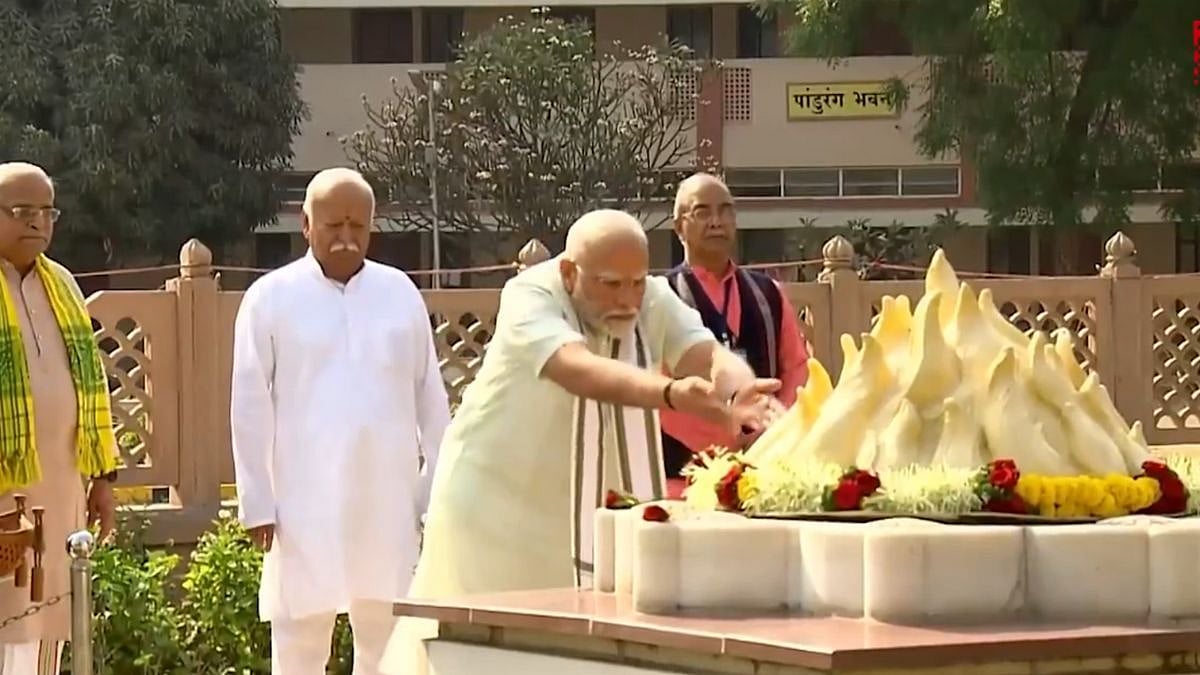Prime Minister Narendra Modi’s visit to Nagpur, to pay homage to RSS founder Dr Keshav Baliram Hedgewar in the centennial year of the organisation, was hardly surprising. Nor was the apparent bonhomie between Modi and RSS sarsanghchalak Mohan Rao Bhagwat, given their long association. The riots that erupted a fortnight prior to the PM’s visit, however, hold implications for the Sangh-BJP dynamic.
The visit, the first by a sitting PM, has been interpreted as a peacekeeping mission after an extended period of froideur. The success of reconciliation efforts after the setback in the general elections was reflected in the results of the Maharashtra assembly polls. But the recent hardening of the Hindutva stance by some of the Sangh frontal organisations could become a matter of concern.
In Nagpur, for example, eyewitness accounts indicate that gratuitous provocation by members of the Vishwa Hindu Parishad and Bajrang Dal contributed to the disturbances. By all accounts, public sentiment was largely indifferent to the demand for levelling Aurangzeb’s tomb. But Maharashtra Chief Minister Devendra Fadnavis came dangerously close to an apologist stance when he claimed that public anger had been ignited by the film Chhava, which depicts the Maratha struggle against the Mughal emperor.
Clearly, action against the provocateurs will be left to the judiciary, as in the case of the 2020 Delhi riots. Five years after the fact, the courts have directed an FIR against Delhi minister Kapil Mishra, whose provocative speech allegedly contributed to communal tensions.
Other than northeast Delhi, incidents of communal violence under Modi’s stewardship have largely been confined to skirmishes during religious processions or protests against clearing of lands encroached by members of the minority community. The Sambhal and Nagpur riots are of another order altogether. In both cases, Sangh workers have advanced the agenda of reclaiming or destroying monuments dating back to the Mughal era. In the words of Bhagwat, there is a new-found tendency “to look for a Shivling under every mosque”.
Mobilising swayamsevaks around perceived historical wrongs can only create discord and undermine Modi’s Viksit Bharat agenda. Significant success has been achieved in Make in India, but there is still a long way to go. If India is to pursue its China-plus-one strategy and become a global manufacturing hub, it cannot afford large-scale disruptions. Communal violence could lead to internet shutdowns that will impact Global Capability Centres (GCCs) and other businesses. Likewise, interruption of transport will impact manufacturing. In addition, the Modi government would like to maintain the positive relationships it has forged in the Middle East.
In June 2022, Bhagwat indicated that the RSS was not in favour of launching another Ramjanambhoomi-style campaign around the disputed Krishna Janambhoomi site in Mathura and the Kashi Vishwanath Temple complex in Varanasi. The Kashi issue, he said, would be settled amicably between the majority and minority communities. The statement attracted blowback on social media, which may have induced the Sangh leadership to modify its stand.
The RSS number two, Dattatreya Hosabale, declared that swayamsevaks were free to support the claim to the Mathura and Kashi sites, though the Sangh would not associate itself with such endeavours. Lest this emboldens the RSS cadre to lay claim to other sites, Hosabale cautioned them to draw the line there. Echoing Bhagwat, he said it was absurd to “start digging up 30,000 mosques”.
It is for the Sangh leadership to ensure that its frontals, notably the VHP and the Bajrang Dal, follow that dictum. Otherwise, civil unrest could undo a decade of good work. Pressure from hardliners on social media, or from the cadre itself, will be short-lived, provided they are not oxygenated by RSS frontals and affiliates.
The give-and-take between the Sangh and the BJP has been an ongoing exercise from day one. In the very first year of Modi 1.0, RSS frontals opposed the Land Acquisition Ordinance, which the government subsequently abandoned. In Modi 2.0, the Bharatiya Kisan Sangh objected to the farm laws of 2020, which were withdrawn. At the same time, key boxes on the Sangh agenda were ticked, from the building of the Ram Temple at Ayodhya to the Triple Talaq law and the abrogation of Article 370.
There are always points of difference. For example, the Sangh-affiliated Bharatiya Mazdoor Sangh is strongly opposing two of the four labour codes. But there are no deal-breakers, because the mother ship and the BJP need each other. The Sangh’s annual pratinidhi sabha in Bangalore last month was a relaxed affair, the overarching sentiment being that the Modi government has been ‘anukool’ (conducive) for the Sangh. Its influence has never been as pervasive as it is today.
Prima facie, the BJP may appear to have outgrown the Sangh, but the Sangh remains its ideological mentor and its on-ground connect. Historically, distance from the RSS has never worked well for the BJP because fresh recruits are no substitute for ideologically committed cadres. Modi, for his part, has owned his RSS origins with pride and has never allowed friction to become confrontation, unlike the fractious relationship between the Sangh and the BJP under Atal Behari Vajpayee.
Going forward, Modi will need the backing of the Sangh not only in the upcoming assembly polls but also in managing the domestic impact of shifting winds in global trade. As both Bhagwat and Hosabale indicated, there are far more important issues to be addressed than, in the words of the Supreme Court, revisiting the past “to oppress the present and the future”. Viksit Bharat demands peace.
Bhavdeep Kang is a senior journalist with 35 years of experience in working with major newspapers and magazines. She is now an independent writer and author.
